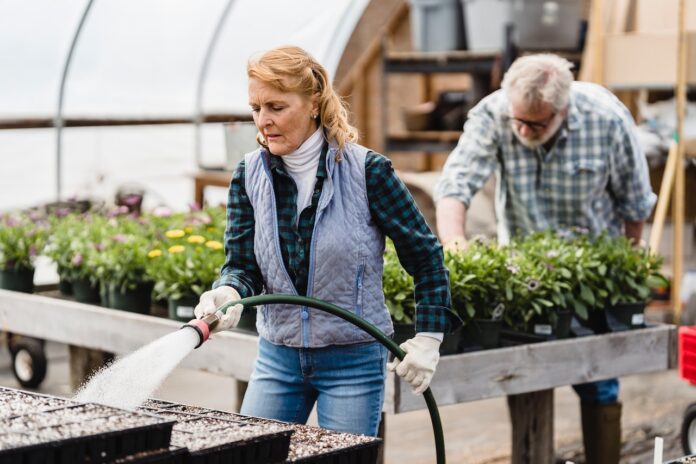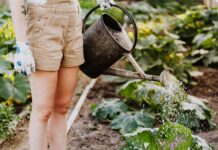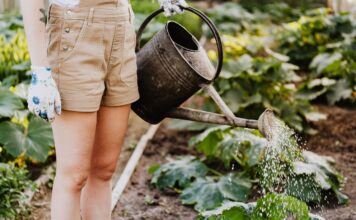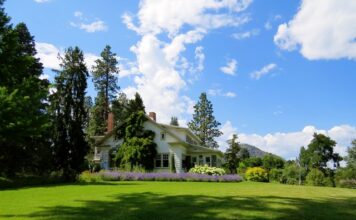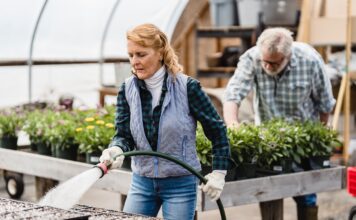In this comprehensive guide to container gardening, readers will learn about the different types of containers and materials, the importance of high-quality soil and its amendments, and how to plan their gardens effectively. Additionally, the article covers planting techniques, watering, fertilizing, pest control, and maintenance tips. It also provides ideas for creative container garden variations, such as vertical gardening and fairy gardens. By the end of this article, readers will have a solid understanding of the ins and outs of container gardening and be equipped with the knowledge to easily create and maintain their own thriving container gardens.
Understanding Container Gardening
Container gardening is a versatile and adaptable way to grow a variety of plants in small spaces. This method involves growing plants in containers, such as pots, hanging baskets, or even plastic bags, instead of planting them directly in the ground. In this article, we’ll discuss the definition and benefits of container gardening, common types of containers used, and the various materials that can be used to create them.
Definition and Benefits of Container Gardening
Container gardening is the practice of growing plants, including flowers, vegetables, herbs, and even small trees, in containers rather than in the ground. This method allows gardeners to maximize space and have more control over their plants, as they can easily move containers to provide the best growing conditions for each plant. Container gardening also encourages creativity in designing and arranging plants, making it a popular choice for urban dwellers with limited outdoor spaces such as patios, balconies, and rooftops.
There are several benefits to container gardening, including:
- Flexibility: With container gardening, you can grow a wide range of plants in limited space, as well as change the arrangement of the containers as needed to accommodate seasonal or personal preferences.
- Better control over growing conditions: Containers provide better control over elements such as soil type and moisture, leading to healthier plants. This can be particularly beneficial for growing plants that may not thrive in your area’s native soil or are susceptible to specific pests and diseases.
- Adaptability: Container gardening is ideal for urban living, as it allows you to grow plants in areas where traditional in-ground gardening is not possible, such as on a balcony or rooftop.
- Reduced weeding and pest issues: Growing plants in containers can reduce the need for weeding and pesticides, as containers often make it more difficult for weeds and pests to access your plants.
- Improved accessibility: Container gardening can make gardening easier for those with limited mobility or strength, as containers can be elevated or placed at a comfortable height for easier access.
Common Types of Containers
There is a wide array of containers available for gardening, ranging from traditional pots and planters to more unconventional options like recycled containers or fabric bags. Some common types of containers include:
- Pots: Traditional pots come in a variety of materials, sizes, and shapes, including round, square, or rectangular. They typically have drainage holes at the bottom to prevent over-watering.
- Window boxes: These elongated containers attach to windowsills or railings, and are ideal for growing flowers or herbs in locations with limited space.
- Hanging baskets: These containers suspend from hooks or chains and provide an attractive, vertical element to container gardening. They are often used for growing trailing plants or flowers that benefit from added air circulation.
- Raised beds: Raised beds are large, rectangular containers typically made of wood or metal that are elevated above the ground. They provide gardeners with better control over soil quality and drainage and are more easily accessible.
- Fabric bags or grow bags: These soft-sided, breathable containers are made of fabric and are great for growing vegetables or plants with deep root systems.
Materials for Containers
Containers for gardening can be made from a wide range of materials, each with its own advantages and drawbacks. Some popular container materials include:
- Plastic: Lightweight and inexpensive, plastic containers are a popular choice for gardeners. They can be found in a variety of sizes and styles, and many are UV-resistant to prevent cracking or fading.
- Clay or terracotta: These natural materials provide excellent drainage, helping to prevent root rot. However, they can be heavy and may crack in cold temperatures.
- Ceramic: Ceramic containers are heavier and more durable than clay pots and come in a wide array of colors and patterns. They also retain moisture better than clay or terracotta pots.
- Wood: Wooden containers provide a natural, rustic appearance and can be constructed in different sizes and shapes. They are durable and insulating, but can rot over time if not properly treated or maintained.
- Metal: Metal containers are durable and can add an industrial or modern aesthetic to your garden. However, they can rust and may become hot to the touch when exposed to sunlight.
- Concrete: Concrete containers are exceptionally durable and provide excellent insulation for plant roots. They can be quite heavy and are typically best suited for larger plants or permanent installations.
When selecting a material for your container, consider factors such as weight, durability, and aesthetics, as well as the specific needs of the plants you plan to grow.
Planning Your Container Garden
Before starting a container garden, it’s essential to plan to ensure you have the right space, location, and plants to create a beautiful and thriving garden. In this article, we will discuss some important steps to consider when planning your container garden, including determining the right space and location, selecting the right plants, and combining plants and design for the perfect container garden.
Considering Space and Location
The first step in planning your container garden is determining how much space you have available for your garden. Consider the size of your balcony, patio, or other outdoor areas where you plan to place your containers. This will help you determine the number, size, and types of containers you can use.
When selecting a location for your container garden, consider the following factors:
- Sunlight: Most plants need at least 6 to 8 hours of sunlight per day. Choose a location that receives adequate sun for the plants you want to grow. South, east, or west-facing locations are ideal for sun-loving plants, while north-facing locations may be suitable for shade-loving plants.
- Shelter: Ensure your plants are protected from strong winds and extreme weather conditions. Place containers near walls or fences to provide some shelter or consider using a windbreak.
- Accessibility: Place your containers in a convenient location, which will make it easy to water, fertilize, and maintain them. Accessibility is also important for enjoying your garden and monitoring the growth and health of your plants.
- Drainage: Ensure that the location you choose has proper drainage to prevent water from pooling and causing root rot.
Selecting the Right Plants
It’s important to choose the right plants for your container garden. Factors to consider when selecting your plants include:
- Sunlight requirements: As mentioned earlier, make sure to choose plants that will thrive in the amount of sunlight available in your selected location. This may include full sun, partial sun, or shade-loving plants.
- Size and growth habit: Consider the mature size of the plant and its growth habit, such as upright, spreading, or cascading. This will help you choose plants with compatible growth patterns and ensure they have enough space to grow without competing for resources.
- Color and texture: Choose plants with a variety of colors, textures, and shapes to create visual interest in your garden. This can include foliage plants, flowering plants, and even edible plants.
- Maintenance requirements: Some plants require more maintenance than others, such as pruning, fertilizing, or pest and disease management. Choose plants with maintenance requirements that match your gardening skills and available time.
- Seasonal interest: To enjoy your container garden all year round, select a mix of plants that provide seasonal interest. This can include spring bulbs, summer annuals, autumn foliage, and winter evergreens.
Combining Plants and Design
When planning your container garden, consider the design and the combination of plants. Keep these tips in mind:
- Use the “Thriller, Filler, and Spiller” technique: This design principle involves choosing a tall and dramatic plant for the center (Thriller), surrounding it with plants that fill in the middle space (Filler), and then adding trailing plants that spill over the edge of the container (Spiller). This technique creates a balanced and visually appealing container.
- Color themes: Choose plants with a color scheme that matches your outdoor décor or create a focal point with a specific color. For example, you can use various shades of blue and purple, or bright and warm colors like red, orange, and yellow.
- Texture and shape: Combine plants with different textures, shapes, and sizes to create contrast and visual interest. This can include plants with large and small leaves, spiky and rounded shapes, or smooth and rough textures.
- Layering: Arrange your plants in layers, with the tallest plant at the back or center, medium-height plants in the middle, and shorter or trailing plants at the front or around the edges.
By considering space, location, plant selection, and design, you can create a stunning and thriving container garden that will enhance the beauty and functionality of your outdoor living space. Happy gardening!
Choosing the Right Soil and Amendments
Importance of High-Quality Soil
High-quality soil is of paramount importance for the proper growth and development of plants. The composition of soil has a significant impact on the ability of the plants to take up nutrients and water, establish a healthy root system, and fight off pests and diseases. Furthermore, the appropriate soil also helps in maintaining the right balance of moisture and air, which is crucial in plant growth.
A good quality soil should have the following essential characteristics: 1. Balanced texture: A mix of clay, silt, and sand in appropriate proportions ensures that the soil has the right consistency and drainage capabilities. 2. Optimum pH level: The ideal pH for most plants falls between 6.0 and 7.0, as this neutral range promotes the absorption of essential nutrients. 3. Organic matter: The presence of organic matter provides necessary nutrients for plants while improving soil structure, fertility, and water retention. 4. Active microorganisms: Soil microorganisms play a vital role in decomposing organic matter and transforming nutrients into plant-accessible forms.
Understanding Soilless Mixes
Plant growth and development can also occur in soilless mixes, also known as growth mediums, which have been designed specifically for horticultural uses. These mixtures generally contain a blend of inert materials that provide support for the root system and retain adequate moisture and nutrients required for the plants.
Some common types of soilless mixes include: 1. Peat-based mixes: These are made from sphagnum peat moss, an excellent organic material known for its moisture-retaining properties, along with other ingredients such as perlite or vermiculite for better aeration. 2. Coir-based mixes: Derived from coconut fiber, these mixes are an eco-friendly alternative to peat-based mixes and provide excellent moisture retention and air circulation. 3. Perlite and vermiculite: Both of these materials are added to soilless mixes to improve aeration, water retention, and nutrient holding capacity.
Soilless mixes are best suited for garden setups such as container gardening, hydroponics, and greenhouses, where soilborne pests and diseases are a significant concern. It is important to note that these mixes may not contain the nutrients required for plant growth, so it is necessary to supplement them with the appropriate fertilizers and nutrients.
Selecting and Adjusting Soil Amendments
Soil amendments are additional substances that can be mixed into the soil or growth medium to improve its characteristics, making it more suitable for plant growth. Before selecting and adjusting soil amendments, it is essential to analyze the existing soil’s properties and determine what changes are needed.
Some common types of soil amendments include: 1. Compost: Organic compost is one of the most popular amendments as it improves soil structure, adds nutrients, and encourages beneficial microbial activity. 2. Manure: Animal manure is an excellent source of nitrogen and other nutrients, as well as organic matter, which helps improve soil fertility and water retention. 3. Peat moss: This can be added to the soil to improve moisture retention, especially in sandy soils. 4. Lime or sulfur: These amendments are commonly used to adjust the pH of the soil, with lime increasing pH (making soil less acidic) and sulfur decreasing pH (making soil more acidic).
When adding amendments to the soil, it is vital to follow the recommended application rates and avoid excessive usage that could lead to a decrease in soil quality. Additionally, regular soil monitoring can help identify any nutrient imbalances or pH alterations that may arise, allowing for more accurate adjustments in soil amendment applications. This proactive approach can significantly contribute to the overall health and productivity of your garden or growing environment.
Planting and Transplanting
When growing plants, one of the most crucial aspects is to make sure you are planting and transplanting them correctly. This can make or break the survival and growth of your green companions. In this guide, we will discuss the differences between planting seeds and seedlings, preparing containers and soil, transplanting seedlings, and proper spacing and plant arrangement.
Seeds vs. Seedlings
Seeds and seedlings are at two different growth stages of a plant’s life. Seeds are embryonic plants enclosed in a protective container, while seedlings are young plants that have emerged from the seed-case and have started developing their first leaves.
Deciding whether to plant seeds or seedlings depends on what you want to achieve and the type of plant you are growing. Seeds give you more variety to choose from and can be more budget-friendly. On the other hand, seedlings can save time, as they have already germinated and started growing. Seedlings are especially beneficial when growing vegetables, as they can help you get a head start on the growing season, allowing you to harvest sooner.
Preparing Containers and Soil
Whether you’re planting seeds or transplanting seedlings, preparing the appropriate container and soil is of utmost importance. Containers should have drainage holes to prevent root rot and prevent waterlogged soil.
When selecting soil for planting seeds, you need to use a lightweight and well-draining mix, such as a seed starting mix. This type of soil is specifically formulated for maximum germination and initial growth of seeds.
If you’re transplanting seedlings, a potting mix is more suitable. This mix has higher nutrient content and is perfect for supporting the growth of young plants.
Before planting seeds or transplanting seedlings, fill the container with soil and moisten the soil thoroughly but avoid overwatering. This ensures that the soil is evenly moist and prepared for planting.
Steps for Transplanting Seedlings
Follow these steps when transplanting seedlings:
- Gently remove the seedling from its original container, taking care not to damage the roots. You can use a small gardening tool or your fingers to gently loosen the soil around the roots.
- Create a hole in the new container’s soil large enough to fit the seedling’s root system comfortably.
- Place the seedling into the hole, making sure the roots are straight and not curled upward.
- Gently fill the hole with soil, covering the roots and ensuring there are no air pockets.
- Press the soil around the seedling gently to provide support.
- Water the newly transplanted seedling thoroughly, ensuring that the soil around it is moist but not soggy.
- Monitor and care for the seedling according to the specific needs of the plant species, such as light, temperature, and watering.
Spacing and Plant Arrangement
Proper spacing and plant arrangement are crucial for healthy plant growth, as overcrowded plants can lead to lack of light, poor air circulation, and competition for nutrients and water, which can result in weak and sickly plants.
When planting seeds or transplanting seedlings, follow the recommended spacing and arrangement guidelines indicated on seed packets or plant tags. Generally, taller plants should be positioned at the back or center of a planting bed, while shorter plants should be placed around the perimeter. This ensures optimal sunlight exposure for all plants.
When planting seeds, thin them out once they’ve produced their first true leaves. This will give the remaining plants enough room to grow and develop properly. It’s essential to monitor your plants’ growth and adjust their spacing and arrangement as needed because the plants will grow larger and may start to crowd each other.
In conclusion, planting and transplanting require care and attention to ensure the healthiest and most productive plants possible. By choosing whether to plant seeds or seedlings, preparing containers and soil, carefully transplanting young plants, and following proper spacing and arrangement guidelines, you can set your plants up for a successful growing season.
Watering and Fertilizing Your Container Garden
Container gardening is a popular choice for those with limited space or for gardening beginners. It allows for growing a wide variety of plants in a small, controlled environment. One of the essential aspects of maintaining a healthy container garden is understanding proper watering and fertilizing techniques.
Watering Techniques and Tips
The key to proper watering in a container garden is consistency. It is important to establish a regular watering schedule as different plants have different watering needs. Overwatering or underwatering can lead to weak, diseased plants, and a less successful garden overall. Here are some tips to successfully water your plants:
- Determine the water requirements of each plant: Some plants need more water than others, so understanding the specific requirements of each plant species is crucial. Be sure to group plants with similar water needs together in your container garden to make watering more efficient.
- Use a moisture meter: A moisture meter is an invaluable tool for determining when your plants need water. It measures the moisture level in the soil, and will help you decide whether it is time to water your garden or not.
- Water in the morning or evening: Watering during the cooler hours helps to reduce water loss through evaporation. Plus, it ensures that the plants will have access to plenty of water during the hot midday temperatures.
- Water deeply: Make sure you are saturating the entire root system with water, so the plants can efficiently absorb the moisture. Lightly watering plants does not supply enough water to reach the roots, making them more susceptible to stress or disease.
- Use a saucer to catch excess water: Placing a saucer or drip tray under your container garden can help prevent water damage to the surfaces underneath. It also allows for more accurate monitoring of how much water is being absorbed by the containers.
Understanding the Importance of Drainage
Proper drainage in your container garden helps to prevent overwatering and root rot. Be sure to choose containers with holes in the bottom to allow for good drainage. Here are some additional drainage tips:
- Choose the right potting mix: A well-draining potting mix is a must-have for a successful container garden. Look for mixes specifically designed for container gardening, which usually have added perlite or vermiculite to aid in proper drainage.
- Elevate your containers: To further encourage drainage, consider placing your containers on risers or plant stands. This will create space beneath the container for water to flow freely away from the plant’s roots and prevent stagnation.
- Monitor for waterlogged plants: If you notice that your plants are wilting despite having sufficient water, it may be due to lack of drainage. Check for any blockages in the drainage holes and consider repotting the plant in fresh potting mix if necessary.
Fertilizers and Nutrient Requirements
Since container gardens have a limited amount of soil, plants can quickly become depleted of essential nutrients. Proper fertilization is crucial for maintaining a healthy, thriving garden. Start by determining the specific nutrient needs of your plants and choose a fertilizer with an appropriate nutrient ratio.
Organic vs. Chemical Fertilizers
Both organic and chemical fertilizers can be effective in providing the necessary nutrients for your container garden. While organic fertilizers typically release nutrients slower over time, chemical fertilizers are quickly absorbed by plants for immediate use. Which type of fertilizer you choose to use depends on your personal preferences and gardening goals. Consider the following when making your decision:
Organic fertilizers – Made from natural sources such as bone meal, seaweed, or compost, these fertilizers provide nutrients more slowly, but tend to improve overall soil health. Organic fertilizers can be pricier and may require more frequent applications.
Chemical fertilizers – These synthetic fertilizers are created to provide a fast-release, efficient nutrient source for your plants. They are often less expensive but may not contribute to long-term soil health.
Regardless of the type of fertilizer you choose, give your plants a proper feeding schedule and follow the instructions on the fertilizer label to avoid overfeeding, which can lead to poor plant growth or even the death of the plant. With proper watering and fertilizing techniques in place, your container garden will be on its way to success.
Pests, Diseases, and Problems
Common Pests and Organic Control Methods
Garden pests can cause severe damage to vegetables, flowers, and other plants if not managed properly. The most common pests include aphids, whiteflies, slugs, snails, and spider mites. Organic pest control methods are preferred as they are environmentally friendly and safer to use around humans and pets.
- Aphids: These small insects can be found on the underside of leaves, sucking the sap and weakening the plant. Organic control methods include spraying the plants with a mixture of water and dishwashing soap, which suffocates the aphids, or introducing natural predators such as ladybugs and lacewings into the garden. Growing plants like garlic, onions, and chives can also help repel aphids.
- Whiteflies: Similar to aphids, whiteflies feed on plant sap and can cause leaves to yellow and drop off. Insecticidal soap sprays can be used to control whiteflies. Alternatively, introducing beneficial insects such as ladybugs and lacewings helps keep their population in check.
- Slugs and snails: These pests enjoy feeding on the leaves of many plants, especially young seedlings. Organic control methods include setting up beer traps, using diatomaceous earth as a barrier, and handpicking them during the evening hours. Encouraging natural predators like birds, frogs, and ground beetles can also help reduce the slug and snail population.
- Spider mites: These tiny arachnids can cause significant damage to plants by sucking the nutrients from their leaves, leading to yellowing and dropping off. Organic control for spider mites includes spraying plants with water to dislodge them, using insecticidal soap or neem oil, and introducing predatory mites to your garden.
Identifying and Treating Plant Diseases
Identifying and treating plant diseases early is vital to maintain a healthy garden. Below are some common plant diseases and their treatments:
- Powdery mildew: This fungal disease appears as a white, powdery coating on leaves, which can eventually wither and die. Ensure proper spacing between plants for good airflow and avoid overhead watering to minimize humidity. Treatment includes spraying affected plants with a mixture of water, baking soda, and dish soap.
- Blight: Both early and late blight are fungal infections that affect tomatoes, potatoes, and other solanaceous plants, causing discolored and wilting leaves. To prevent blight, practice crop rotation, keep the garden area clean, and avoid overhead watering. Copper-based fungicides can be used to control the spread of blight.
- Root rot: Root rot, caused by a fungus, affects plants with roots in poorly drained soil by turning them mushy and discolored. Prevention methods include proper watering and adequate drainage. Affected plants should be removed and destroyed to avoid spreading the disease.
- Rust: This fungus causes orange or reddish-brown spots on the plant’s leaves. To prevent rust, maintain proper air circulation among plants and avoid overhead watering. Fungicides containing sulfur or copper can be used to control rust, but make sure to follow the product instructions carefully.
Addressing Other Common Problems
Some other common garden problems that you may encounter include:
- Nutrient deficiencies: Yellowing, browning, or slow growth can indicate a lack of nutrients in your garden soil. Regular soil testing can help identify the specific deficiency, and the addition of organic matter, such as compost, can help improve soil quality.
- Overwatering: Overwatered plants may show yellow leaves, wilt, or suffer root rot. Make sure to follow proper watering techniques for your garden, and always check the soil moisture before watering.
- Weeds: Competing with your plants for nutrients, water, and sunlight, weeds can be a major problem in the garden. Regularly pulling weeds out by hand or using organic mulches can help suppress weed growth.
- Weather conditions: Extreme temperatures, high winds, and heavy rain can all cause stress to your plants. Keep an eye on local weather reports and adjust your gardening practices accordingly, such as watering more frequently during hot spells or providing windbreaks for delicate plants.
Maintenance and Care
Proper maintenance and care of your plants is essential for keeping them healthy and looking beautiful for a long time. Maintenance involves several steps, including pruning, pinching, supporting, overwintering, and rotating plants. Following these guidelines will help you ensure your plants stay healthy and beautiful throughout the year.
Pruning and Pinching
Pruning involves removing dead, damaged, or diseased parts of a plant. This helps to prevent the spread of diseases, improves plant health, and encourages new growth. Ideally, you should prune your plants during their dormant season to minimize stress. Many deciduous trees and shrubs are pruned late in the winter, while evergreens can be pruned in early spring.
Pinching is a method of encouraging bushy growth in plants. This is done by removing the growing tips of plants with your fingers, a process known as “pinching out” or “tipping.” Removing the tips encourages the plant to produce more lateral (branching) growth, which results in a fuller, bushier appearance.
When pruning and pinching, it is important to use sharp, clean tools to prevent damage to the plant and minimize the risk of disease transmission. Clean your tools regularly with a mixture of one part bleach to ten parts water to keep them free of pathogens.
Supporting and Staking Tall Plants
Some plants, particularly those with tall, slender stems or heavy fruit loads, may require additional support to grow properly and prevent damage. Staking tall plants like tomatoes, peppers, dahlias, and delphiniums provides the necessary support they need to grow upright and prevent them from toppling over due to heavy fruit or strong winds.
Choose an appropriate stake that is strong enough to support the weight of your plants and tall enough for the plant’s full height. Place the stake in the ground next to the plant and gently tie the plant to the stake using soft cloth or plant ties. It’s important to tie the plant loosely enough to allow some movement but tight enough to provide support. Check the ties regularly and adjust them as needed to accommodate growth.
Overwintering
Many plants, particularly perennials and bulbs, require specific care to survive and thrive during the winter months. Overwintering involves preparing the plants for the cold weather and protecting them from frost and cold temperatures.
Mulching the soil around the base of the plants with a layer of organic material, such as straw, leaves, or wood chips, helps to insulate the plant’s roots, retain soil moisture, and reduce the risk of heaving (plants being pushed out of the ground by alternating freezing and thawing soil). You can also use frost blankets, cloches, or other protective coverings to help shield your plants from cold temperatures and frost damage.
In addition to these protective measures, remember to water your plants thoroughly before the ground freezes, as they will still need moisture throughout the winter, especially evergreens.
Rotating and Refreshing Plantings
Rotating plants in your garden or containers is an important aspect of maintaining healthy plants and minimizing the risk of soil-borne diseases and pests. By changing the location of plants each season or year, you can help prevent the build-up of harmful organisms in the soil and give previous planting sites a chance to recover and rebuild valuable nutrients.
Additionally, refreshing your plantings by replacing old, unproductive, or diseased plants with new, healthy ones can help maintain the overall health and beauty of your garden or container. Regularly adding organic materials like compost or aged manure to your garden beds or containers can improve soil fertility and structure, promoting healthier plants and a more vibrant garden.
Container Gardening Variations and Ideas
Container gardening is a versatile and adaptive approach to growing plants in limited spaces or where ground garden beds are not available. It allows individuals to utilize their balconies, patios, and even indoor spaces to create attractive and functional gardens. This article will discuss various container gardening ideas, including vertical gardening, miniature and fairy gardens, edible and culinary plants, and arranging containers for decorative effect.
Vertical Gardening
Vertical gardening is a fantastic container gardening idea for those looking to maximize their limited spaces or those hoping to create a living privacy screen. Using vertical containers and plant supports, this style of gardening focuses on growing plants upwards rather than spreading out horizontally. It is an excellent option for individuals with small balconies or patios, as it utilizes height for additional growing spaces.
To start a vertical container garden, select appropriate containers with drainage holes at the bottom. Consider choosing recycled or repurposed materials, such as old pallets, ladders, shoe organizers, or even wall-mounted mason jars for an environmentally friendly approach. Incorporate various supports, including trellises, stakes, or wire mesh to encourage upward growth.
Suitable plants for vertical gardens are those that can be trained to grow vertically or those that naturally climb, such as ivy, clematis, climbing roses, cucumbers, tomatoes, and beans. Remember to position your vertical garden in a location with adequate sunlight, proper air circulation, and access for watering and maintenance.
Miniature and Fairy Gardens
Miniature and fairy gardens are whimsical, creative container gardening designs ideal for those desiring a magical touch in their spaces. These gardens involve creating miniature landscapes and scenes using small plants, ornaments, figurines, and carefully chosen containers.
To create a miniature or fairy garden, start by selecting a suitable container with drainage holes. The container should be deep enough to support the root systems of your chosen plants but allow for decorative elements. Examples of ideal containers include wide-mouthed pots, troughs, repurposed wooden boxes, or even wheelbarrows.
For plants, choose small, slow-growing varieties that suit the scale of your miniature garden. Alpine plants, succulents, low-growing ground covers, and small herbs are excellent choices. Consider incorporating mosses and sedums for texture and ground cover, and use miniature figurines, tiny houses or castles, and miniature garden tools to set your scene.
Growing Edible and Culinary Plants
Container gardening is not limited to decorative plants. Many edible plants, including vegetables, fruits, and herbs, grow well in containers. This gardening option allows individuals to grow their own food and cultivate culinary plants in limited spaces, such as balconies or sunny kitchen windows.
For a successful edible container garden, choose containers with adequate depth and drainage for each plant’s root system. Select plant varieties specifically bred for container gardening, such as compact or dwarf varieties. Ensure each plant has adequate sunlight, proper spacing for growth, and regular watering and fertilization.
Some suitable edible plants for container gardening include tomatoes, peppers, peas, salad greens, strawberries, and a variety of herbs such as basil, thyme, and mint.
Arranging Containers for Decorative Effect
Arranging containers within your container garden can create stunning focal points and define spaces. To achieve a decorative effect in your garden, consider the following techniques and design principles:
- Vary container size: Utilize containers of varying heights, shapes, and sizes to create a visually dynamic arrangement.
- Group plants with similar needs: Keep plants with similar water, light, and soil requirements together to ensure they all thrive in their shared container.
- Create color and texture combinations: Mix plants with varying foliage colors and textures, and consider season-long interest by including plants that bloom at different times.
- Balance: Achieve harmony by combining elements that complement one another. For example, placing a tall, architectural plant in a large container surrounded by smaller, flowery plants creates a captivating visual effect.
- Create height and depth: Arrange containers on multi-level plant stands, stack crates or bricks for added elevation, or use hanging planters to create varying levels of height.
Remember to regularly assess and maintain your container garden, rotating plants as needed and caring for their individual requirements. With some creativity and attention, your container garden will flourish and provide enjoyment and function for years to come.
1. What are the essential components to start a successful container garden?
To start a successful container garden, select appropriate containers with proper drainage, high-quality potting soil with good water retention, suitable plants compatible with container dimensions, and a location with the correct amount of sunlight for chosen plants.
2. How often should one water their container garden plants?
Watering frequency depends on several factors, including plant species, potting material, and weather conditions. Generally, container plants need water when the top inch of soil feels dry to the touch or when a moisture-meter indicates a need for watering.
3. What is the role of fertilizers in container gardening, and how often should one use them?
Fertilizers provide essential nutrients to promote plant growth and vitality. In container gardening, soil nutrients diminish quickly as plants consume them. Apply either slow-release or diluted liquid fertilizers every 4-6 weeks during the growing season.
4. Can one grow vegetables in container gardens, and what are suitable vegetables to grow?
Many vegetables thrive in container gardens, offering fresh produce without requiring large garden spaces. Suitable vegetables include tomatoes, peppers, eggplants, leafy greens, and compact varieties of cucumbers and squashes.
5. How to prevent pests and diseases in container gardens?
Prevent pests and diseases by practicing proper plant spacing, adequate watering, monitoring for signs of infestation, and promptly removing affected plants. Consider using natural pest-deterrents (e.g., essential oils, neem oil, or insecticidal soap).
6. What are some tips for maintaining a healthy container garden during extreme weather conditions?
During hot weather, increase watering frequency and use mulch to retain moisture. Provide shade cloth during extreme heat. In cold conditions, move containers indoors or near a sheltered wall. Cover vulnerable plants with frost protection fabric or grow crops that tolerate cooler temperatures.

